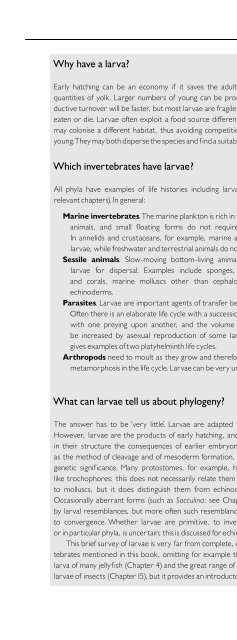An Introduction to the Invertebrates, Second Edition - tiera.ru
An Introduction to the Invertebrates, Second Edition - tiera.ru
An Introduction to the Invertebrates, Second Edition - tiera.ru
Create successful ePaper yourself
Turn your PDF publications into a flip-book with our unique Google optimized e-Paper software.
LARVAE235Why have a larva?Early hatching can be an economy if it saves <strong>the</strong> adult from providing largequantities of yolk. Larger numbers of young can be produced and <strong>the</strong> reproductiveturnover will be faster, but most larvae are fragile and very many will beeaten or die. Larvae often exploit a food source different from <strong>the</strong> adult’s, andmay colonise a different habitat, thus avoiding competition between adult andyoung.Theymayboth disperse<strong>the</strong> species and find a suitablehabitatfor <strong>the</strong> adult.Which invertebrates have larvae?All phyla have examples of life his<strong>to</strong>ries including larvae (see figures in <strong>the</strong>relevantchapters).In general:Marine invertebrates.The marine plank<strong>to</strong>n is rich in food, readily dispersesanimals, and small floating forms do not require special adaptations.In annelids and c<strong>ru</strong>staceans, for example, marine animals nearly all havelarvae, while freshwater and terrestrial animals do not.Sessile animals. Slow-moving bot<strong>to</strong>m-living animals almost always uselarvae for dispersal. Examples include sponges, hydroids, anemonesand corals, marine molluscs o<strong>the</strong>r than cephalopods, barnacles andechinoderms.Parasites. Larvae are important agents of transfer between parasite hosts.Often <strong>the</strong>re is an elaborate life cycle with a succession of hosts, commonlywith one preying upon ano<strong>the</strong>r, and <strong>the</strong> volume of reproduction maybe increased by asexual reproduction of some larval stages. Figure 6.4gives examples of two platyhelminth life cycles.Arthropods need <strong>to</strong> moult as <strong>the</strong>y grow and <strong>the</strong>refore readily incorporatemetamorphosisin<strong>the</strong> life cycle.Larvae can be very unlike <strong>the</strong> adults.What can larvae tell us about phylogeny?The answer has <strong>to</strong> be ‘very little’. Larvae are adapted <strong>to</strong> <strong>the</strong>ir environment.However, larvae are <strong>the</strong> products of early hatching, and <strong>the</strong>refore may showin <strong>the</strong>ir st<strong>ru</strong>cture <strong>the</strong> consequences of earlier embryonic development, suchas <strong>the</strong> method of cleavage and of mesoderm formation, which do have phylogeneticsignificance. Many pro<strong>to</strong>s<strong>to</strong>mes, for example, hatch as larvae ra<strong>the</strong>rlike trochophores: this does not necessarily relate <strong>the</strong>m closely <strong>to</strong> annelids or<strong>to</strong> molluscs, but it does distinguish <strong>the</strong>m from echinoderms and chordates.Occasionally aberrant forms (such as Sacculina: see Chapter 13) can be placedby larval resemblances, but more often such resemblances must be attributed<strong>to</strong> convergence. Whe<strong>the</strong>r larvae are primitive, <strong>to</strong> invertebrates as a wholeorin particular phyla, is uncertain; thisis discussed forechinodermsin Chapter17.This brief survey of larvae is very far from complete, even concerning invertebratesmentioned in this book, omitting for example <strong>the</strong> sessile scyphis<strong>to</strong>malarva of many jellyfish (Chapter 4) and <strong>the</strong> great range of aquatic and terrestriallarvae of insects (Chapter15), but it provides anintroduc<strong>to</strong>ry overview.











